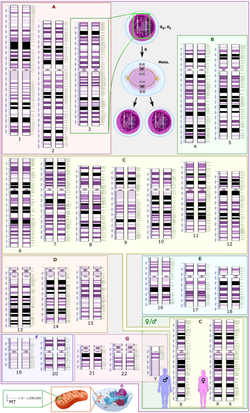Monosomy

Editor-In-Chief: Prab R Tumpati, MD
Obesity, Sleep & Internal medicine
Founder, WikiMD Wellnesspedia &
W8MD medical weight loss NYC and sleep center NYC
| Monosomy | |
|---|---|

| |
| Synonyms | |
| Pronounce | N/A |
| Specialty | N/A |
| Symptoms | Varies depending on the specific chromosome affected |
| Complications | Developmental delays, physical abnormalities, infertility |
| Onset | Congenital |
| Duration | Lifelong |
| Types | N/A |
| Causes | Chromosomal deletion |
| Risks | |
| Diagnosis | Karyotype analysis |
| Differential diagnosis | Trisomy, other chromosomal abnormalities |
| Prevention | Genetic counseling |
| Treatment | Symptomatic and supportive care |
| Medication | N/A |
| Prognosis | Varies widely |
| Frequency | Rare |
| Deaths | N/A |
Monosomy is a type of chromosomal abnormality in which there is loss of one chromosome from a normal diploid organism. This can occur in any chromosome, but is most commonly seen in the sex chromosomes. Monosomy can lead to a variety of genetic disorders, depending on the specific chromosome that is missing.
Causes[edit]
Monosomy can occur due to a variety of reasons. The most common cause is nondisjunction, which is the failure of a pair of chromosomes to separate properly during meiosis. This can result in one gamete receiving two copies of a chromosome and the other receiving none. If a gamete missing a chromosome fertilizes with a normal gamete, the resulting offspring will have monosomy.
Types[edit]
There are several types of monosomy, including:
- Turner syndrome: This is a condition in which a female is missing one X chromosome. Symptoms can include short stature, infertility, and heart defects.
- Cri du chat syndrome: This is caused by a deletion of the short arm of chromosome 5. Symptoms can include intellectual disability, delayed development, and a distinctive cry that sounds like a cat.
Diagnosis[edit]
Monosomy can be diagnosed through a variety of methods, including karyotyping, fluorescence in situ hybridization (FISH), and comparative genomic hybridization (CGH).
Treatment[edit]
There is currently no cure for monosomy. Treatment typically focuses on managing symptoms and improving quality of life. This can include physical therapy, speech therapy, and educational support.
See also[edit]
Ad. Transform your life with W8MD's Budget GLP-1 injections from $75


W8MD offers a medical weight loss program to lose weight in Philadelphia. Our physician-supervised medical weight loss provides:
- Weight loss injections in NYC (generic and brand names):
- Zepbound / Mounjaro, Wegovy / Ozempic, Saxenda
- Most insurances accepted or discounted self-pay rates. We will obtain insurance prior authorizations if needed.
- Generic GLP1 weight loss injections from $75 for the starting dose.
- Also offer prescription weight loss medications including Phentermine, Qsymia, Diethylpropion, Contrave etc.
NYC weight loss doctor appointmentsNYC weight loss doctor appointments
Start your NYC weight loss journey today at our NYC medical weight loss and Philadelphia medical weight loss clinics.
- Call 718-946-5500 to lose weight in NYC or for medical weight loss in Philadelphia 215-676-2334.
- Tags:NYC medical weight loss, Philadelphia lose weight Zepbound NYC, Budget GLP1 weight loss injections, Wegovy Philadelphia, Wegovy NYC, Philadelphia medical weight loss, Brookly weight loss and Wegovy NYC
|
WikiMD's Wellness Encyclopedia |
| Let Food Be Thy Medicine Medicine Thy Food - Hippocrates |
Medical Disclaimer: WikiMD is not a substitute for professional medical advice. The information on WikiMD is provided as an information resource only, may be incorrect, outdated or misleading, and is not to be used or relied on for any diagnostic or treatment purposes. Please consult your health care provider before making any healthcare decisions or for guidance about a specific medical condition. WikiMD expressly disclaims responsibility, and shall have no liability, for any damages, loss, injury, or liability whatsoever suffered as a result of your reliance on the information contained in this site. By visiting this site you agree to the foregoing terms and conditions, which may from time to time be changed or supplemented by WikiMD. If you do not agree to the foregoing terms and conditions, you should not enter or use this site. See full disclaimer.
Credits:Most images are courtesy of Wikimedia commons, and templates, categories Wikipedia, licensed under CC BY SA or similar.
Translate this page: - East Asian
中文,
日本,
한국어,
South Asian
हिन्दी,
தமிழ்,
తెలుగు,
Urdu,
ಕನ್ನಡ,
Southeast Asian
Indonesian,
Vietnamese,
Thai,
မြန်မာဘာသာ,
বাংলা
European
español,
Deutsch,
français,
Greek,
português do Brasil,
polski,
română,
русский,
Nederlands,
norsk,
svenska,
suomi,
Italian
Middle Eastern & African
عربى,
Turkish,
Persian,
Hebrew,
Afrikaans,
isiZulu,
Kiswahili,
Other
Bulgarian,
Hungarian,
Czech,
Swedish,
മലയാളം,
मराठी,
ਪੰਜਾਬੀ,
ગુજરાતી,
Portuguese,
Ukrainian


